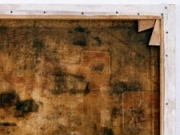CANVAS PAINTINGS CONSERVATION WORKSHOP
The canvas paintings conservation workshop has been in operation since 1999. Housed in the Museum’s new wing, it employs two conservators who conserve painted works created with oils or tempera on canvas, engineered wood, or other modern materials.
Attending to the needs of the collection, the workshop undertakes both preventive and interventional conservation. Having been stored in unsuitable conditions for many years – and, in many cases, without stretchers – most of the works in the collection are in need of direct intervention to counter friability, instability, serious warping and rips. The conservation methods and materials used are reversible and – as far as possible – compatible with the original materials used.
 | Proskynetarion, 1793 (Â×Ì 1837), prior to restoration. The work has clearly suffered from ageing, loosening, insect and fungus attacks, the loss of some of the matière in the painted layer, rips, corrosion spreading from its nails, oxidized varnish and a thick layer of atmospheric pollutants and surface residue. |
 | Proskynetarion, 1793 (Â×Ì 1837); view of the back of the work. |
 | Proskynetarion, 1793 (Â×Ì 1837). The pilgrim’s inscription and the date (1793) on the back of the canvas made it impossible to reinforce (back) the work using conventional materials. |
 | Proskynetarion, 1793 (Â×Ì 1837), after conservation. After searching far and wide for a way of using a translucent backing material to reinforce the work effectively without concealing the elements on the back of the canvas, a number of trials were carried out using various combinations of adhesive materials, fabrics and modes of application. Ultimately, it was elected to apply a combination of wax, resins and glass fabric, using a heated table; the results proved excellent. |
 | Proskynetarion, 1793 (Â×Ì 1837), after conservation. After searching far and wide for a way of using a translucent backing material to reinforce the work effectively without concealing the elements on the back of the canvas, a number of trials were carried out using various combinations of adhesive materials, fabrics and modes of application. Ultimately, it was elected to apply a combination of wax, resins and glass fabric, using a heated table; the results proved excellent. |
 | Proskynetarion, 1793 (Â×Ì 1837), the conservation procedures now complete. |













